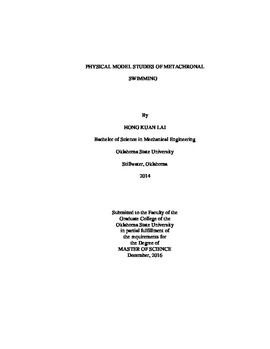| dc.contributor.advisor | Santhanakrishnan, Arvind | |
| dc.contributor.author | Lai, Hong Kuan | |
| dc.date.accessioned | 2018-06-29T14:41:02Z | |
| dc.date.available | 2018-06-29T14:41:02Z | |
| dc.date.issued | 2016-12-01 | |
| dc.identifier.uri | https://hdl.handle.net/11244/300357 | |
| dc.description.abstract | Aquatic crustaceans such as copepods, krill and shrimp spend most of their life cycle swimming. These organisms have been studied for their ecological importance, as they form a crucial link between smaller phytoplankton and larger, commercially important fishes. Crustaceans employ a unique drag-based strategy for swimming in which 4-5 closely spaced pairs of limbs are periodically oscillated in the tail to head direction. Each of their swimming limbs (pleopods) are phase-shifted in time relative to the neighboring limb, resulting in a metachronal wave traveling in the same direction as the animal. We developed a dynamically scaled robotic model of metachronal swimming to investigate: 1) Reynolds number (Re) scalability of the mechanism, and 2) the importance of inter-pleopod spacing and stroke amplitude (SA) on swimming hydrodynamics. The tethered robotic model consisted of acrylic linkages and plastic bevel gears mounted on a base plate. Physical models of pleopods were constructed using acrylic plates with hinges, to mimic the asymmetric pleopod deformation observed in power and recovery strokes of swimming. The entire assembly was mounted on top of a glass aquarium filled with water-glycerin fluid mixtures of varying viscosities for dynamic scaling. 2D particle image velocimetry (PIV) measurements across Re ranging from 10 to 1000 showed that propulsive flows change from horizontally oriented (thrust-generating) at low Re to angled vertical jets (lift-generating) at larger Re. Adult crustaceans typically need to contend with negative buoyancy, and thus this finding suggests that the propulsive jets can aid in weight support as well as thrust generation. The inter-pleopod gap to pleopod length ratio (G/L) in metachronal swimmers has been observed to be within a narrow range of 0.2-0.65. We used 2D PIV to examine the effect of varying G/L on the propulsive flows. Our results showed that synergistic hydrodynamic interactions occur between adjacent pleopods in the form of alternating suction and expulsion jets. For a given design G/L and Re, increasing SA resulted in augmenting thrust-generating flow. For the maximum SA and largest Re investigated, the lowest G/L ratio case showed lift-generating flow, suggesting that synergistic interactions can modulate the propulsive flow direction in metachrony. | |
| dc.format | application/pdf | |
| dc.language | en_US | |
| dc.rights | Copyright is held by the author who has granted the Oklahoma State University Library the non-exclusive right to share this material in its institutional repository. Contact Digital Library Services at lib-dls@okstate.edu or 405-744-9161 for the permission policy on the use, reproduction or distribution of this material. | |
| dc.title | Physical Model Studies of Metachronal Swimming | |
| dc.contributor.committeeMember | Jacob, Jamey | |
| dc.contributor.committeeMember | Delahoussaye, Ronald | |
| osu.filename | Lai_okstate_0664M_14969.pdf | |
| osu.accesstype | Open Access | |
| dc.description.department | Mechanical & Aerospace Engineering | |
| dc.type.genre | Thesis | |
| dc.type.material | text | |
